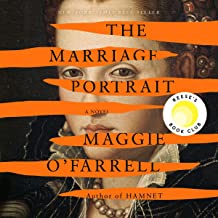The Marriage Portrait by Maggie O’Farrell
Those who have read the complex works of Maggie O’Farrell, especially her previous historical fiction, Hamnet (Tinder Press), or her memoir, I Am, I Am, I Am (Tinder Press), know they are in for a rare treat when O’Farrell announces she is back on the historical fiction scene — this time in The Marriage Portrait (Knopf), featuring a royal family, an arranged marriage, a trapped duchess, and a famous poem by Robert Browning.
The Marriage Portrait follows the tragic tale of the incredibly young Lucrezia de Medici, who was happy to be the black sheep of her family — only to find herself forced to marry and become the Duchess of Ferrara after the sudden death of her sister. The talented artist finds herself thrust into the public eye as the Duchess opposite her arranged husband, Alfonso II d’Este, Duke of Ferrara, and pressured to provide him with an heir.
It’s only when, two years into their marriage, Lucrezia becomes suspicious that her husband intends to kill her if she remains unable to give him a son. Was she right to be suspicious, and if she was, how could she keep herself alive in a remote region with a trained soldier?
THE IMPORTANCE OF THE PORTRAIT
When we think of personal or family portraits from the Italian Renaissance, we immediately think of beautifully, carefully depicted renditions of a person that are meant to capture their greatest qualities and merits on canvas, for all to see, for years to come. Their virtue becomes immortalized on the wall on which their portrait is hung. This, of course, implies a certain sense of vanity but also the prioritization of public appearances and how one is received.
For the entire book to be titled after a portrait suggests the lack of depth that was found in this marriage, but also the immense prioritization of social constructs over the entrapped Duchess’s feelings. The Marriage Portrait tracks not only the transformation of Lucrezia into the Duchess but also the extent to which her life and personality is taken away through an arranged marriage, violent household and coercive pregnancy.
A POEM’S FOREBODING MESSAGE
Poet Robert Browning’s poem, “My Last Duchess,” was a muse for this novel, and the cues the Duke of Ferrara takes from the poem are startling. The remarks about the subject’s fair skin, flush, and bosom all suggest that the woman being painted is young, just like Lucrezia.
However, there are two other remarks made in the poem that are much more startling and suggest how objectified the woman in the poem must be within her marriage — much like Lucrezia arguably was in hers. Browning writes, “That’s my last Duchess painted on the wall, / Looking as if she were alive,” which is all at once an eerie remark but suggests that the late Duchess is replaceable.
There is also this remark in the final lines of the poem, “Though his fair daughter’s self, as I avowed / At starting, is my object,” which implies his objectification of his partner, as well as the importance of her beauty over her substance.
These implications could easily be applied to the Duke of Ferrara, as well, who clearly was more invested in appearances, political gain, and an heir, than he ever was in a wife.
SURELY ONE STORY OF MANY MORE TO COME
Maggie O’Farrell is an incredible crafter of story and poetic description, and she writes historical fiction that is factual, powerful and incredibly immersive. Lucrezia’s character is a strong, compelling contender next to O’Farrell’s previous depiction of Shakespeare’s only son, and she surely should not be O’Farrell’s final historical portrait. Rather, we would encourage O’Farrell to continue to write historical fiction until we have an entire gallery of these creatively and dramatically depicted portraits to choose from.
About Maggie O’Farrell:
Maggie O’Farrell, FRSOL, is the author of Hamnet, Winner of the Women’s Prize for Fiction 2020, and the memoir I Am, I Am, I Am, both Sunday Times no. 1 bestsellers. Her novels include After You’d Gone, The Distance Between Us, which won a Somerset Maugham Award, The Vanishing Act of Esme Lennox, The Hand that First Held Mind, which won the 2010 Costa Novel Award, Instructions for a Heatwave, This Must Be the Place, and The Marriage Portrait. She is also the author of two books for children, Where Snow Angels Go and The Boy Who Lost His Spark. She lives in Edinburgh.





